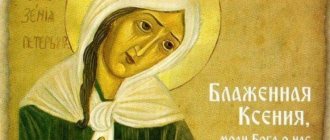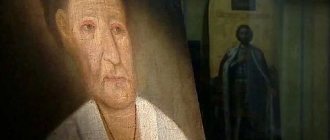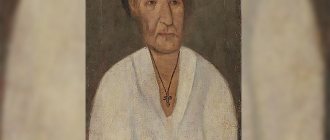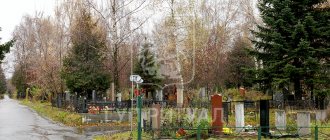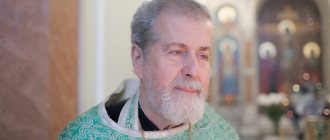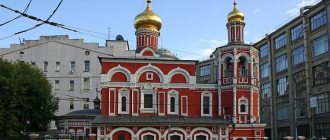In the first quarter of the 18th century, a loving couple, the Petrovs, lived in St. Petersburg on Vasilievsky: Ksenia Grigorievna and Andrei Fedorovich. They lived in perfect harmony, not knowing troubles, but suddenly grief happened: the young husband died, barely having time to say farewell words to his beloved wife. The whole life of 26-year-old Ksenia turned upside down overnight. She renounced worldly things, gave away property, put on the clothes of her late husband and set off to wander around the city. She ordered to call herself Andrei Fedorovich, and to consider Ksenia deceased. So she decided to atone for her husband’s sins by doing godly deeds, because he died without Christian communion.
When her husband’s clothes had decayed, Ksenia dressed in a simple shirt and skirt and wore shoes on her bare feet. Both in winter and summer she had no shelter or permanent shelter. She spent her nights in the field in prayer. When the Smolensk Church was being built, Ksenia of Petersburg carried building stone at night, which surprised her contemporaries a lot. She lived on alms, but only accepted pennies, and even those she gave to the poor. Even during her lifetime, the residents of St. Petersburg noticed the righteous woman’s gift of insight: if she asks a person for something, then some kind of loss awaits him; if Ksenia gives someone a gift, that person will have a profit or a successful resolution of a difficult matter. The cab drivers considered it an honor to give her a ride in their carriage, because whoever gives her a ride will have a successful day. And many other wonderful signs and beliefs have developed over the years of the holy feat of Xenia of St. Petersburg.
For more than 40 years, Ksenia walked around St. Petersburg, and communication with her bore fruit in the form of an increase in the morality of the townspeople and a decrease in crime. People began to notice that the blessed one’s attention, expressed even in a few words, averts trouble and restores health; learned to take care of the poor, orphans, and the hungry. And the fact that St. Petersburg is called the cultural capital is largely due to her.
Ksenia Petersburgskaya: how to get there, opening hours
The grave where Ksenia of Petersburg is buried is located at the Smolensk cemetery in the Chapel.
The easiest way to get there is by metro, including for non-residents, since it is available at every railway station.
Get off at one of the stations:
- Vasileostrovskaya
- Primorskaya
Opposite the metro exit, every 10 - 15 minutes there is a shuttle bus (small), number K-249a. The cost is 34 rubles.
From the Vasileostrovskaya metro station, go to the end (10 minutes).
From the Primorskaya metro station - 3 stops.
From the gate, walk past the Smolensk Church and turn left along the path.
Address: Vasileostrovsky district, st. Kamskaya, house 24
Prayer to Saint Blessed Xenia of St. Petersburg
To enter and venerate the sarcophagus, under which the grave of the righteous woman is located, there is always a line into the chapel. While waiting, people read the akathist to Blessed Xenia of St. Petersburg or write a letter to her. There is a box for letters, and previously people put their notes in the cracks of the chapel. They write requests and gratitude; these messages are published in the newspaper “Smolensk Temple”. Those who cannot come send letters to the temple with a request to pray for them, and in the response letter they receive rose petals moistened with oil from Ksenyushka’s lamp.
Prayer of Ksenia of Petersburg for marriage and the gift of children
“Oh holy all-blessed mother Ksenia! Having lived under the protection of the Most High, led and strengthened by the Mother of God, having endured hunger and thirst, cold and heat, reproach and persecution, you have received the gift of clairvoyance and miracles from God and are resting in the shadow of the Almighty. Now the Holy Church, like a fragrant flower, glorifies you. Standing at the place of your burial, before your holy image, as if you were alive and present with us, we pray to you: accept our petitions and bring them to the throne of the merciful Heavenly Father, as you have boldness towards Him, ask for eternal salvation for those who flow to you, for good deeds and our undertakings are a generous blessing, deliverance from all troubles and sorrows. Stand before our All-Merciful Savior with your holy prayers for us, unworthy and sinners. Help, holy blessed mother Xenia, to illuminate the infants with the light of holy baptism and seal the gift of the Holy Spirit, to educate boys and girls in faith, honesty, fear of God and grant them success in learning; heal the sick and ailing, send down love and harmony to families, honor monastics to strive for good deeds and protect them from reproach, strengthen pastors in the strength of the Holy Spirit, preserve our people and country in peace and serenity, pray for those deprived of communion of the Holy Mysteries of Christ in the dying hour. You are our hope and hope, quick hearing and deliverance, we send thanks to you and with you we glorify the Father and the Son and the Holy Spirit, now and ever, and unto ages of ages. Amen."
about marriage and the gift of children READ
hide
Prayer of Ksenia of Petersburg for love and health
“Oh, simple in your way of life, homeless on earth, but heir to the abodes of the Heavenly Father, blessed wanderer Xenia! Just as we previously fell into your tombstone of illness and sorrow and were filled with consolations, now we (names), overwhelmed by pernicious circumstances, resort to you and ask with hope: pray, O good heavenly God, that our steps may be corrected, according to the word of the Lord, to the doing of His commandments, and may the godless atheism that has captivated your city and your country, plunging us, many sinners, into mortal hatred of our brothers, proud self-indignation and blasphemous despair, be abolished. Oh, most blessed one of Christ, who has put to shame the vanity of this age, ask the Creator and Giver of all blessings to grant us humility, meekness and love in the treasure of our hearts, faith in strengthening prayer, hope in repentance, strength in a difficult life, merciful healing of our soul and body , chastity in marriage and caring for our neighbors and sincere ones, renewal of our entire life in the purifying bath of repentance, as we praise your memory with all praise, let us glorify in you the miracle worker, the Father and the Son and the Holy Spirit, the Trinity Consubstantial and Indivisible forever and ever. Amen."
about love and health READ
hide
Prayer to Ksenia of St. Petersburg for family well-being
“Oh, our glorious holy blessed mother Ksenia, warm prayer book for us before God! As before we fell to your tombstone, now we, after your glorification, resort to your relics, we ask: pray to the Lord to sanctify our souls and bodies, to enlighten our minds, to cleanse our conscience from all filth, unclean thoughts, evil and blasphemous intentions and from all exaltation, pride and arrogance, arrogance and insolence, from all Pharisee hypocrisy, and from all our cold and evil customs; May He grant us sincere repentance, contrition of our hearts, humility, meekness and quietness, reverence, and spiritual intelligence with all prudence and thanksgiving. Hidden from the wise of this age, but known to God, ask our Russian country for deliverance from cruel troubles, for renewal and correction of our entire life, keep us in every pious Orthodox confession of the Christian faith, so that we may be worthy to please you all the days of singing, giving thanks and glorify the Father and the Son and the Holy Spirit, the Trinity of One Essence, Life-Giving and Indivisible forever and ever. Amen."
about family well-being READ
hide
Prayer to Blessed Xenia for help
“Oh holy servant of God, blessed Ksenia! Look mercifully with your eye on us, servant of God (names), tenderly praying to your honorable icon and asking you for help and intercession. Extend your warm prayers to the Lord our God and ask for forgiveness of sins for our souls. Behold, with a contrite heart and a humble spirit, we call on you to be a merciful intercessor to the Lady and a prayer book for us sinners, as if you have received from Him the grace to pray for us and deliver us from troubles. We therefore ask you, do not despise us, unworthy, who pray to you and demand your help, and intercede for everyone everything that is useful for salvation, for by your prayers to the Lord God, having received grace and mercy, we will glorify all the good Source and Gift-Giver and the One God, glorified in the Trinity of Saints. Father and Son and Holy Spirit, now and ever and unto ages of ages.”
about help READ
hide
Liturgy in the temple is celebrated daily at 10 am. On holidays and Sundays - at 7 am and at 10. Evening services begin at 6 pm in winter and at 5 pm in summer. Prayers and memorial services are served starting at 11 on weekdays and from 10 on holidays. The Chapel of Saint Xenia of St. Petersburg is open to visitors until 5 pm. Postal address: 199048, St. Petersburg, Vasilievsky Island, Kamskaya 24, rector Archpriest Viktor Moskovsky.
Chapel of Saint Xenia of St. Petersburg
Some facts about Ksenia
- She is the daughter of godly parents from the noble class. She regularly attended church, where she met her betrothed. Andrei was a colonel, a singer in the Palace Orchestra.
- Suddenly, having lost her beloved husband, she realized that she was no longer attracted to earthly comforts, but was worried about the fate of her husband, who did not have time to take communion. She decided to devote her life to prayers for herself and Andrei.
- She lived for 45 years without a roof over her head. What and how the blessed one ate is unknown. She didn't take any taxes.
- She took only pennies and a horse - the king with a crown on a horse. She gave them to the poor. Sometimes Ksyusha provided help with such pennies.
- There is a known case of how a penny extinguished a beginning fire as soon as a woman with a penny from Ksenia approached her house.
- The Saint died at the age of 71 (1803). Her relics did not immediately appear in the chapel. They were buried in the Smolensk cemetery, with a marble slab on top.
- People went to her, took earth from the grave, some managed to break off a piece from the slab. As a result, the slab was replaced several times.
- A small chapel erected in 1830 was rebuilt in 1902. It was spacious with a tomb over the grave.
- But in accordance with the political situation in the country, changes took place regarding the Chapel: either it was accessible to parishioners, then it was ruined, and again it was rebuilt.
- Finally, the modern Chapel, restored, with a gilded onion, illuminated (1987), became accessible to the people, and it is not difficult to get to it.
Smolensk cemetery and the spiritual patron of the Northern capital is Saint Xenia of Petersburg.
On Vasilyevsky Island there is one of the most famous Russian Orthodox shrines - the chapel of St. Blessed Xenia of St. Petersburg, which is a traditional place of pilgrimage for many Christians. The place that I want to talk about today as part of the thematic week #slovopetersburg is known not only to the majority of St. Petersburg residents, but also to many residents of other regions of Russia. Despite the fact that this place is far from touristic, the flow of people here does not dry out at any time of the year. So, welcome to one of the oldest cemeteries in St. Petersburg - Smolenskoye on Vasilyevsky Island, where one of the most famous Russian Orthodox shrines is located - the famous chapel of St. Blessed Xenia of Petersburg
, which since its foundation has been a traditional place of pilgrimage for many Christians.
My first acquaintance with the Smolensk cemetery happened back in 2005, when I visited it with my friend Alexey ren_ar
. We wanted to see ancient tombstones and monuments of the 17th-19th centuries, to touch a piece of the history of the formation of St. Petersburg.
Many outstanding figures of Russian science and art are buried in the cemetery. Here was the first grave of Taras Shevchenko (1814-1861), then he was moved to Ukraine to Kanev. Alexander Blok was buried here in 1921, and the Blokovskaya path in the cemetery was named after him. The following people also found peace at the cemetery: Academician N.N. Beketov. (1827-1911); admiral, builder of famous battleships Popov A.A. (1821-1898); geographer and traveler Semenov Tian-Shansky P.P. (1827-1914); poet Sologub F.K. (1863-1927); Yakovleva A.R. (1758-1828), nanny A.S. Pushkin and many other famous people. Walking along the grassy cemetery paths, we were surprised and indignant at the severe desolation of the historical part of the cemetery, as well as the widespread destruction of ancient graves to make room for new burials. Even after 12 years, in the cemetery, in the withered grass, you can still find many human bones, and sometimes children’s skulls.
02. Smolensk cemetery. Archival photo of the author. 2006
Getting off at the Primorskaya
“, we passed by the Research Institute of the Arctic and Antarctic on the street.
Bering to the western entrance to the Smolensk cemetery
.
From the entrance to the Smolensk Church there is a central alley, but we decided to turn off from it to examine the remains of ancient tombstones and crosses, located mostly in the northern part of the cemetery. As before, we were greeted by great desolation. Most of the stone tombstones, not yet completely destroyed by time, were hidden in tall, dense weeds. Here and there, fragments of once beautiful monuments and family crypts stuck out... Rusty and rickety crosses looked blindly, erased by time, as nameless signs. On the remains of some ancient tombstones of the 18th–19th centuries, birth and death numbers and half-erased epitaphs were still visible here and there. 03.
The shallow Smolenka River flows through the cemetery, flowing into the Gulf of Finland. Every year, together with groundwater, it increasingly erodes the unfortified banks of the ancient cemetery, taking with it nameless crosses and tombstones to the bottom. The water in the river is relatively transparent and through it you can clearly see the stone and metal crosses located at the bottom, and in some places human bones are visible... In the 8 years since my last visit to the Smolensk cemetery in 2009, new burials, in a barbaric manner, are actively attacking the already “occupied” places have almost half erased the historical part of the cemetery from the face of the earth. I have not been able to find several beautiful remains of monuments that have been memorable to me since 2005... The destruction of the surviving ancient tombstones in the central part of the cemetery is currently hampered by their relative safety, but, as they say, it is not known what will happen tomorrow...
04.
According to my long-time friend, the rector of the oldest operating church in the city in honor of Saints Simeon the God-Receiver and Anna the Prophetess, Archpriest Oleg Skobl: “ The land in the cemetery is state-owned, and the Church only rents the land under the churches, so they cannot in any way influence the destruction of ancient graves for new ones burials...
“There was an unreal silence in the cemetery, no birds sang, no leaves rustled, and every step we took was echoed by the loud sound of twigs breaking under our feet and the rustling of grass.
With sad thoughts from what we had seen, we went out onto the central Petrograd Alley. Along it, close by, there are also numerous ancient graves, from the tombstones of which trees grew, which over many years, from a seed once accidentally blown by the wind, grew to enormous sizes... 05. How old is this unmarked grave?
So we reached the beautiful sky-blue Church of the Smolensk Icon of the Mother of God and turned right to the Chapel of the Blessed Xenia, hidden in the greenery of the trees.
06.
In front of it is another modern chapel, erected in 2001. The sign on it reads as follows: “ In this place was the main altar of the temple in the Name of the Holy Life-Giving Trinity, built according to the design of the architect V.T. Kulchenkov and consecrated in 1831. In 1932, the temple was dismantled into bricks by order of the atheistic authorities
«.
07.
Soon we approached the Chapel of Xenia the Blessed
- one of the most iconic Orthodox shrines in St. Petersburg.
Erected in 1902, according to the design of the architect A. A. Vseslavin, the chapel over the grave of Xenia of St. Petersburg has become a place where pilgrims from all over Russia have been flocking for more than a hundred years. 08. Chapel of Xenia the Blessed.
The chapel was designed in pseudo-Russian style. The facade along the cornice is decorated with semicircular kokoshniks, the arches on the facade and on the extension are decorated with mosaic faces of Christ and Xenia of Petersburg, and the windows are stained glass icons. The building is completed by a tent-shaped roof, topped with a gilded dome with a cross. The main decoration inside the chapel is a marble iconostasis with a mosaic crucifix and a tombstone.
09.
In 1940, the chapel was closed by the authorities, and seven years later it was reopened to parishioners. In 1960 it was closed again, and only in 1983 the chapel was finally returned to the Russian Orthodox Church. After restoration, in August 1987 it was again consecrated and open to the public. Ksenia the Blessed
- one of the most revered Orthodox saints among the people (canonized in 1988).
From the time of her repose to this day, people have come to her grave, asking for the fulfillment of their desires or seeking intercession before God. Even the Soviet authorities could not prevent this, using the chapel either as a warehouse or as a shoemaker’s or art workshop - people still came to the chapel and left notes with their aspirations. 10. Prayer to Saint Xenia of Petersburg.
Unfortunately, we were not able to get inside, since it was already late and the chapel was closed. To the left of the entrance, under the face of Saint Xenia, on the wall there is a marble plaque, the inscription on which reads: “ In the name of the Father and the Son and the Holy Spirit. The servant of God, Blessed Ksenia Grigorieva, the wife of singer Andrei Fedorovich, is buried in this chapel. After leaving her husband for 26 years, she wandered for 45 years. In widowhood she was called by her husband's name: Andrei Fedorovich. Her total life on earth was 71 years. In 1794-1796, she took part in the construction of the Smolensk Church, secretly carrying bricks on her shoulders at night for the church under construction
«. «
Whoever knew me, let him remember my soul for the salvation of his soul. Amen
«.
11.
Since the flow of people to the chapel does not dry up from morning to evening in any weather, a small cast-iron fence and an improvised candlestick with protection from rain and wind were built under the sign, where anyone can light a candle, write a note or put flowers. No one will remember where the tradition of leaving notes asking for help or expressing gratitude came from, but years go by, and people still write and write, believing that Ksenia will definitely help... In Soviet times, her dilapidated chapel was surrounded by a plank fence, and A constant vigil was established to prevent anyone from approaching her, and for going to church they were expelled from work and from institutes. But, despite such measures, people constantly came to Ksenyushka and left her notes outlining their troubles and requests. These notes were thrown over the fence, stuck into the cracks between the boards, and all the boards of the fence were covered with words of prayer and gratitude for the help provided.
12. Notes with requests.
Her special gift was to organize the family lives of many people. So, one day, having come to the Golubev family, blessed Ksenia announced to a 17-year-old girl: “ You are making coffee here, and your husband is burying his wife on Okhta. Run there quickly!
“The embarrassed girl did not know how to respond to such strange words, but blessed Ksenia literally forced her with a stick to go to the Okhtinskoye cemetery in St. Petersburg.
There, a doctor buried his young wife, who died in childbirth, sobbing inconsolably and finally losing consciousness. The Golubevs tried to console him as best they could. This is how they met. After some time it continued, and a year later the doctor proposed to Golubeva’s daughter, and their marriage turned out to be extremely happy. There are countless such cases of Blessed Xenia’s help in building a family - she truly became the creator of human destinies. For more than 200 years, the grave of Blessed Xenia has been a source of healing, effective help in difficult circumstances, and a solution to insoluble problems. Thus, Blessed Ksenia appeared to one person who was suffering from wine drinking and said threateningly: “ Stop drinking!”
The tears of your mother and wife flooded my grave ."
Need I say that this man never touched the bottle again? Even such a serious illness as epilepsy is within the power of the great saint of God. There is a known case. Daria Tarasovna Kulichkova from St. Petersburg was exhausted with her eldest daughter, who had epilepsy. Wherever she took her, to whatever means she resorted. Uselessly. Kind people told her about Ksenia. I went to the Smolensk cemetery with my daughter. We rented an apartment nearby and faithfully went to the blessed chapel for a week, every day, as if going to work. They ordered a prayer service and prayed in their own words. It helped. My daughter has not had seizures for three years now. 13.
Emperor Alexander III, when he was his heir, fell ill with typhus in severe form. Tsarina Maria Feodorovna was very alarmed by her husband’s illness. One of the valets, seeing her in the corridor, told her how blessed Ksenia helps the sick, gave her sand from the treasured grave and added that he himself was healed of illness through the prayer of the righteous woman. The Grand Duchess put sand under the sick man's pillow, and that same night, sitting at the head of the bed, she had a vision of blessed Xenia, who told her that the sick man would recover and a daughter would be born into their family. She should be called Ksenia. The blessed woman's prediction came true exactly. On the website of the Smolensk parish, which unites the temple in the name of the Smolensk Icon of the Mother of God at the Smolensk cemetery, the chapel of St. Blessed Xenia of Petersburg and the Church of the Resurrection of Christ, there is a special section “Collection of modern testimonies of miracles through the prayers of St. Blessed Xenia of Petersburg,” where people from all over Russia they talk about how Saint Xenia helped them. You can read the evidence at the following link.
14.
Who was the patron saint of St. Petersburg during her lifetime? Saint Xenia
(by patronymic Grigorievna) was the wife of Colonel Andrei Fedorovich Petrov, who served as a court singer.
At twenty-six years old, Ksenia was widowed and seemed to have lost her mind from grief. She distributed her property to the poor, dressed in the clothes of her late husband and, as if forgetting her name, called herself by the name of her late husband - Andrei Fedorovich. These oddities were not associated with a loss of reason, but only meant complete contempt for earthly goods and human opinion, which places these goods at the center of existence. So Ksenia of Petersburg took upon herself the difficult feat of foolishness for Christ’s sake. Earthly, transitory goods ceased to have any value for her. Ksenia had a house, but she gave it to a friend with the condition that it provide shelter for the poor. Having no shelter herself, Ksenia wandered among the poor people of St. Petersburg, and at night she went into the field, where she spent time in fervent prayer. When they began to build a church at the Smolensk cemetery, Ksenia secretly carried bricks to the top of the building after dark, thereby helping the masons build the walls of the temple. 15. Tombstones of the family of the St. Petersburg merchant of the 1st guild I. I. Antonov.
Some of Ksenia’s relatives wanted to accommodate her and provide her with everything necessary for life, but the blessed one answered them: “ I don’t need anything.
“She was glad of her poverty and, coming somewhere, sometimes remarked: “
I’m all here.
“When her late husband’s clothes decayed, Ksenia dressed in the poorest clothes, and on her feet she put torn shoes without stockings.
She did not wear a warm dress, but made her body suffer from the cold. Feeling the greatness of the spirit of Blessed Xenia, the residents of St. Petersburg loved her because she despised earthly things for the sake of the Kingdom of Heaven. If Ksenia entered someone's house, this was considered a good sign. Mothers were happy if she kissed the child. The cab drivers asked the blessed one for permission to carry her for a little while, since after that the income was guaranteed for the whole day. Traders at the bazaars tried to give her kalach or some kind of food. And if blessed Ksenia took anything from what was offered, then all the seller’s goods were quickly sold out. 16.
Ksenia had the gift of insight. On the eve of Christmas 1762, she walked around St. Petersburg and said: “ Bake pancakes, tomorrow all of Russia will bake pancakes.
“The next day, Empress Elizabeth Petrovna died suddenly.
A few days before the murder of the royal youth John VI (Antonovich, the great-great-grandson of Tsar Alexei Mikhailovich), who in infancy was proclaimed Russian emperor, the blessed one cried and repeated: “ Blood, blood, blood.
“A few days after Mirovich’s failed plot, young John was killed.
Blessed Xenia died at the end of the 18th century, but tradition has not preserved either the year or the day of her death. Her burial is at the Smolensk cemetery, where she helped build the church, after which, soon, a pilgrimage to her grave began... To the right of the chapel there is a grave with a beautiful old tombstone in the shape of a small chapel. The inscription says that the 10-year-old girl Shurochka Mikruleva is buried here. 17.
After examining the monument, we headed to the Church of the Smolensk Icon of the Mother of God
, where we attended the evening service for a short time.
There were a lot of people in the temple, so we had to stand almost at the very doors. In 1758, the wooden Smolensk Church was founded at the Smolensk cemetery. It was built in two years and consecrated on September 30, 1760. And in 1786-1790, according to the design of the architect A. A. Ivanov, the stone Smolensk Church was built in the style of early Russian classicism. On October 1, 1790, the main altar was consecrated in the name of the Smolensk Icon of the Mother of God. 18. Temple of the Smolensk Icon of the Mother of God.
The architecture of the temple is a rectangular building with a two-tier bell tower, painted blue. The refectory is adjacent to the church on the west side. A bell tower topped with a gray spire rises above the entrance. In both tiers of the bell tower there are belfries. The wall of the second tier is decorated with Corinthian pilasters. Each face of the tier is completed with a triangular pediment. The church has three entrances - one front and two side. Each of the entrances is decorated with a portico. The temple is crowned with a low gray dome, located on a low drum with arched windows modeled on the Byzantine style. The dome is completed by a lantern topped with a bulbous dome with a cross. Since the early 1920s, the church was owned by renovationists. And in 1938, the Kazan Icon of the Mother of God, which came from the Kazan Cathedral, was transferred to it, and two years later the Smolensk Church was closed. The Kazan Icon of the Mother of God was transferred to the Prince Vladimir Cathedral, where it remained for 60 years (in 2001 it was returned to the Kazan Cathedral). The interior of the temple was destroyed.
19.
In 1947, the church was returned to the parish and on March 8 of the same year it was solemnly consecrated by the rector of the St. Nicholas Cathedral, Archpriest Pavel Tarasov. An iconostasis was installed in the central chapel, delivered from the Church of the Nativity of John the Baptist on Kamenny Island, which was closed in 1938. Near the temple there is a memorial stone, which says that this place was the original burial place of the great poet of Ukraine Taras Shevchenko
. And a little further away there is one of the most beautiful tombstones of the family of the St. Petersburg merchant of the 1st guild I. I. Antonov.
20.
Shevchenko died in St. Petersburg on his birthday, February 26, 1861. The servant assigned to the academician of the Imperial Academy of Arts heard his last will: “ Before Kanev...
- and the poet’s heart stopped.
But his body was not immediately transported to Kanev. Despite the fact that Taras Shevchenko served the required 10 years of exile, he was never rehabilitated and continued to be considered a political criminal who was under surveillance. Therefore, the burial of the unreliable Shevchenko in Ukraine required official permission from the authorities. Friends decided to bury him in St. Petersburg, and after obtaining permission to decide on a permanent burial place. Taras Shevchenko was buried at the Smolensk Orthodox cemetery, near the cathedral. Dostoevsky, Leskov, Saltykov-Shchedrin, Turgenev, Nekrasov, representatives of the Ukrainian, Polish and Greek communities of St. Petersburg came to the funeral service. Academician Shevchenko lay in an expensive wooden coffin corresponding to his rank, which was placed in a metal box before burial so that the earth would not damage either the body or the tree, because over time Shevchenko’s ashes had to be returned to Ukraine. Herzen published a heartfelt obituary in Kolokol. Shevchenko's death in Russia was perceived as a great loss for literature and the liberation movement. From the Smolensk Church we headed to the eastern entrance to the cemetery from Kamskaya Street, where the Holy Gate, built according to the design of the architect L. Ruska in 1807-1809, and the dilapidated Church of the Resurrection of Christ are located. On the wall of the gate hangs a marble memorial plaque, on which is carved the inscription that Pushkin’s famous nanny Arina Rodionovna
.
21.
Arina Rodionovna Yakovleva, was born on April 10, 1758 in the village of Suida (now the village of Voskresenskoye), or rather, half a mile from Suida, in the village of Lampovo, Koporsky district, Petersburg province. Her mother, Lukerya Kirillova, and father, Rodion Yakovlev, were serfs and had seven children. Arina was her home name, but her real name was Irina or Irinya. As a serf peasant, the nanny did not have a surname. In documents (revision tales, church registers, etc.) she is named after her father - Rodionova, and in everyday life - Rodionovna. They called her Rodionovna in her old age, as is sometimes done in villages. Pushkin himself never called her by name, but wrote “nanny” in his letters. It is known that Pushkin wrote down seven fairy tales from her words. It was from her that he first heard about the hut on chicken legs and the tale of the dead princess and the seven heroes. In literature she is more often referred to as Arina Rodionovna, without a surname, or, less commonly, under the surname Yakovleva. Arina Rodionovna died at the age of seventy, at the end of July 1828, in St. Petersburg, in the house of Olga Pavlishcheva (Pushkina). Neither Pushkin nor his sister were present at the funeral. Olga's husband Nikolai Pavlishchev buried the nanny. Arina Rodionovna had no relatives in St. Petersburg, and the gentlemen did not care about the nanny’s grave either. The unmarked grave was soon lost. Only in 1940, as a result of painstaking searches in the archives, it was possible to establish that the nanny’s funeral service was held in the Vladimir Church. In the registry book of this church they found an entry dated July 31, 1828 No. 73: “ 5th class official Sergei Pushkin serf woman Irina Rodionova 76 old age priest Alexey Narbekov
".
It also turned out that she was buried in the Smolensk cemetery, although the grave itself was never found. The long-existing version that the nanny was buried at the Bolsheokhtinsky cemetery was rejected. On the Internet, on various forums, inquisitive people organize entire conferences dedicated to finding the nanny’s grave. For St. Petersburg residents, the search for this burial is probably akin to the search for the Amber Room in their native Kaliningrad. No, let a message slip through that someone saw a barely noticeable pebble with a half-erased inscription “Arina Rodionovna” on the border of the cemetery... Near the Holy Gate there is an ancient Church of the Resurrection
, built according to the design of the architect V. A. Demyanovsky in a completely uncharacteristic for that time, Naryshkin Baroque style.
The project was approved and the church was founded on June 16, 1901. On May 2, 1904, the main altar was consecrated in the name of the Resurrection of Christ. It was decorated with a gilded carved baroque iconostasis with mosaic images based on sketches by the artist V. M. Vasnetsov. 22. Church of the Resurrection, beginning of restoration. Archival photo of the author. 2009
The church is an unplastered red brick building, crowned by three domes. The three chapels inside are separated by blank partitions and are essentially isolated churches. The corners of the facade are decorated horizontally with white stripes, the windows are decorated with stucco molding in the Russian style. On August 10, 1921, a funeral service was held for the poet Alexander Blok in the Church of the Resurrection. In January 1930, the Church of the Resurrection was closed and converted into a dormitory. Church valuables and interior decoration were destroyed, domes were knocked down. In 1977, a pumping station was built there. During the work, the vaults in the basement were broken and metal structures were made. In 1989, work was stopped. In 1991, the church was returned to the St. Petersburg diocese in real ruins. By the way, on the northern wall of the temple the granite and brick are dotted with bullet holes. There is an opinion that in this place, during the troubled years of the Revolution, priests were shot at the direction of the atheistic authorities, and the bodies were thrown into unmarked mass graves on the territory of the Smolensk cemetery...
23.
Unfortunately, wet weather did not allow us to explore this ancient cemetery longer and in more detail... We were forced to go back... But, in the future, when visiting the glorious city of St. Petersburg, I will definitely come to the chapel of Blessed Xenia of St. Petersburg once again.
24.
Where to stay
Every year there are more and more pilgrims to the chapel of Xenia of St. Petersburg. The parish, unfortunately, does not have the ability to accept guests. Pilgrims can look for a hotel in the city monasteries. The closest, for example, is the Ioannovsky Stavropegic Convent, which is located on Petrogradka.
Another option is to rent a room in a nearby area (from 850 rubles per day) or stay in a small hotel or hostel (out of season and on weekdays, a double economy class room can be found for a price from 600 rubles per day). Those who have nowhere to sleep at all find shelter in the temple for all possible help.
Temple architecture
The author of the architectural project was architect A. Vseslavin; in his work he relied on the pseudo-Russian style. The Chapel of Blessed Xenia is a landmark of the Smolensk Orthodox Cemetery, located on Vasilyevsky Island.
The chapel was built in the style of Russian classicism using a modest image and a small series of additional fragments. It is a rectangular building in shape, decorated with a round “Byzantine” drum; A two-row bell tower adjoins the building.
In the church there is a shrine with the relics of St. Xenia of St. Petersburg
Blessed Ksenia will certainly help everyone who sincerely turns to her. There is a tradition of bringing handwritten notes to the grave of the reverend elder. It is recommended to walk around the temple three times, then put the letter in a specially prepared box or leave it against the wall. Next, you need to lean against the building, mentally convey your message to the saint and light a candle. After this ritual, you can go to the temple and order a prayer service.
